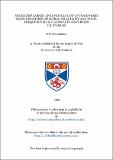Files in this item
Microchip lasers : an investigation of transverse mode definition, spectral selectivity and novel frequency modulation/up-conversion techniques
Item metadata
| dc.contributor.advisor | Sinclair, Bruce | |
| dc.contributor.author | MacKinnon, Neil | |
| dc.coverage.spatial | 155 p. | en_US |
| dc.date.accessioned | 2018-06-06T10:00:10Z | |
| dc.date.available | 2018-06-06T10:00:10Z | |
| dc.date.issued | 1994-07 | |
| dc.identifier.uri | https://hdl.handle.net/10023/13751 | |
| dc.description.abstract | In this thesis describes experimental and theoretical work is described for a class of solid-state lasers which are classified by the term "microchip". The work presented here may be grouped into two parts. Chapters 2 and 5 describe work directed towards novel frequency modulation and up-conversion and are therefore of a more developmental flavour. The work presented in chapters 3 and 4 are of a more fundamental nature and pertains to transverse mode definition and spectral selectivity in these devices. In chapter 2 a laser diode array pumped, electro-optically tunable microchip laser is described. Based on the combined gain/non-linear material neodymium doped magnesium oxide lithium niobate (Nd:MgO:LiNbO3) tuning of the six oscillating axial modes was achieved at a sensitivity of 8.9 MHz V-1 mm. Chapter 3 describes the mechanisms observed to define the transverse mode of operation in lithium neodymium tetraphosphate, LiNdP4O12, or LNP, microchip lasers. This material was of interest in this particular study in that the dn/dT of the material was negative and would clearly preclude the guiding mechanisms postulated for the Nd:MgO:LiNbO3 microchip laser as described in chapter 2. The LNP microchip laser was excited by a Ti:sapphire laser and a HeNe based Fizeau interferometer was used to map out the pump induced changes in optical thickness between the cavity mirrors. Further investigation using a modified interferometer revealed that definition of the transverse mode of operation was primarily due to pump induced input surface deformation. The single frequency properties of a laser diode pumped LNP device, as a function of gain length, are the subject of chapter 4. The diode pumped LNP device output exhibited the same excellent spatial characteristics of operation as the Ti:sapphire pumped device. Fourteen milliwatts of single frequency output was obtained. A model, based on spatial dephasing of longitudinal modes, was modified appropriately to predict the single frequency performance of the LNP device as a function of gain length within the resonator. Chapter 5 deals with developmental work on a laser diode array pumped, composite material microchip laser for green output. The device consisted of a neodymium doped yttrium vanadate (Nd:YVO4) gain section in intimate optical contact with a non-linear material (potassium titanyl phosphate, or KTP) for frequency doubling of the 1.064 ?m line in Nd:YVO4. Initial experiments on the device were performed using a laser diode and coupling optics. Six milliwatts of C.W. green power were obtained for 150 mW of incident pump radiation. The device operated in a near diffraction limited spatial mode (M2=1.1) at all the incident pump powers. The oscillating waist within the device was found to be pump power dependent. The conversion of the fundamental into the green was observed to be only slightly reduced by the variable elliptical eigenpolarisation within the cavity. (Abstract shortened by ProQuest.) | en_US |
| dc.language.iso | en | en_US |
| dc.publisher | University of St Andrews | |
| dc.subject.lcc | TK7871.3M3 | |
| dc.subject.lcsh | Lasers | |
| dc.title | Microchip lasers : an investigation of transverse mode definition, spectral selectivity and novel frequency modulation/up-conversion techniques | en_US |
| dc.type | Thesis | en_US |
| dc.type.qualificationlevel | Doctoral | en_US |
| dc.type.qualificationname | PhD Doctor of Philosophy | en_US |
| dc.publisher.institution | The University of St Andrews | en_US |
This item appears in the following Collection(s)
Items in the St Andrews Research Repository are protected by copyright, with all rights reserved, unless otherwise indicated.

